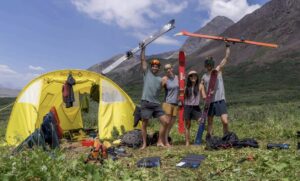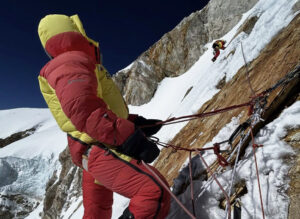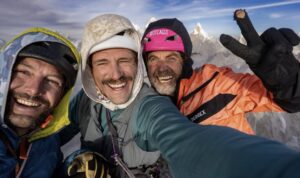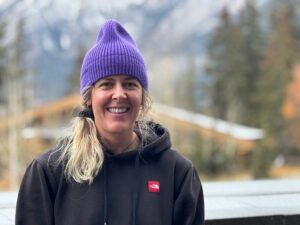Recently, Helias Millerioux of France was invited to the Banff Mountain Film Festival to share his views about the future of alpinism. We spoke to him in an exclusive interview, largely about that topic, and came away impressed by his thoughtfulness.
Millerioux won a Piolet d’Or in 2018 for an impressive 2,200m new route on the Nuptse massif. It was rated ED+, the hardest in the alpine classic graduation. He still climbs in the Himalaya and Karakoram every year, always pursuing high-difficulty climbs in alpine style.
With this pure approach, of course, failure is much more common than success in mountaineering. He walked away without a summit, for example, on Trivor (Batura range, Karakoram) with Jannick Grazianni in 2024, and on the West Face of Manaslu with Charles Dubouloz and Symon Welfringer in 2022.
Fake revolution
Millerioux defends a slow, gradual evolution in alpinism, in contrast with the high-publicity achievements seen on social media and large media outlets.
“Changing things in alpinism takes time, and each generation of climbers puts a little stone on the top of their mountains,” he says. “But there are no revolutionary changes [through expeditions] that are based only on logistics.”
By “logistics,” he means helicopters, huge support teams, abundant oxygen, fixed ropes. Logistics-based achievements, he says, steal the chance of doing a “world first” by fair means and showing the wider public — which pays most attention to firsts — how it should be done. Skiing down the Hornbein Couloir or climbing winter K2 without supplementary oxygen would have had a much greater impact on future generations of mountaineers, he feels, without the huge support.
“In this modern world, everything is possible,” Millerioux said. “All feats can be achieved with the new technologies, gear, and logistics. We alpinists are not explorers anymore. However, we have a responsibility to the next generation for what we do in the mountains.”
He is concerned that wider audiences may think that an Everest ski descent must be done with supplementary oxygen, when it can be done without.

Helias Millerioux during the interview. Photo: Jerry Kobalenko
Always a mountain guide
As he pointed out, the problem with strictly following the values of alpine style and aiming for excellence is that the chances of success are much lower. Big sponsors want triumphs to publicize on Netflix documentaries.
“That is why I still earn my living as a mountain guide, guiding 100 days a year,” he noted.
He says that he has some gear sponsorship, and the grants from some mountaineering associations may help pay for an expedition, but they don’t provide a living.
When we asked him what he would do if money were no issue, Millerioux didn’t hesitate: He would keep climbing without either sponsors or social media, but he wouldn’t quit guiding.
“I love guiding, it’s been my dream since I was a child, and right now, I have the freedom to choose who I have as a client and what we do.”
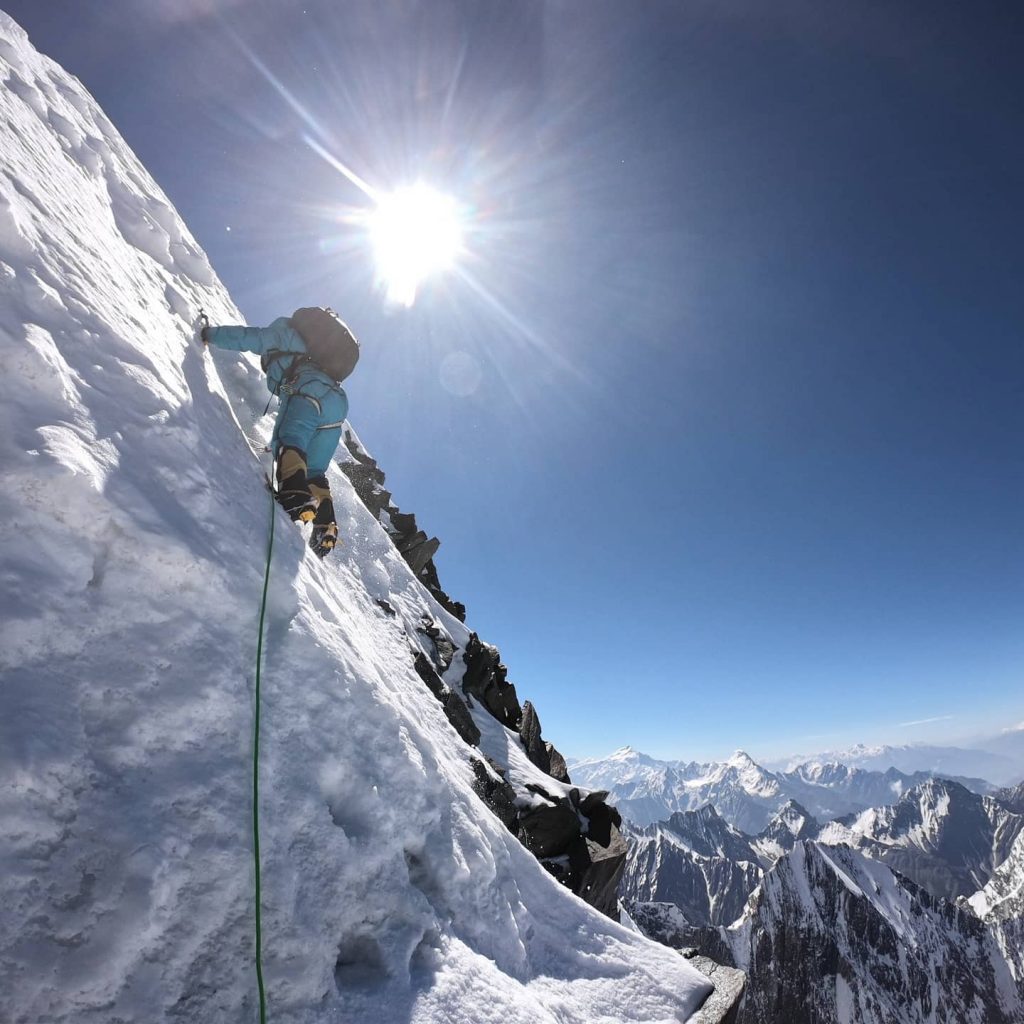
On Rakaposhi Southwest Ridge. Photo: Helias Millerioux
The next generation
We asked Millerioux, who is now 38, about the new generation of French climbers, including Benjamin Vedrines and Nicolas Jean, and also the young members of the High Mountain Military Group. Then there are the three 20-somethings who recently free-climbed la Directe de la Amitie on the North Face of the Grandes Jorasses.
Is this a particularly strong generation?
“I think the new generation of climbers is super strong because they do more rock climbing and they are better trained,” he replied. “But it’s happening everywhere, not only in France.”
Commitment vs. danger
We also asked him about risk management and the line between brave and reckless.
“Risk tolerance is a personal value that changes from climber to climber, and I am not here to judge anyone about it,” he replied. “But we have to differentiate between commitment and danger.”

A member of the French team deals with steep, snowy terrain on Diram Peak. Photo: Helias Millerioux/Facebook
Commitment in climbing is similar to that in deep diving or polar expeditions: You go as far as you decide…Commitment is in the DNA of climbers and is part of the adventure. But danger is like deciding to pitch your tent under a looming serac and stay there for a week and see what happens.
The mess on the 8,000’ers
Then there’s what he saw on the 8,000’ers, especially with Nepalese guides and their clients.
Millerioux and his team acclimatized on the normal route of Manaslu before launching an attempt to the West Face in the fall of 2022. He was shocked when he saw hundreds of people heading for the summit in clearly dangerous conditions.
“There was that avalanche above Camp 4 that swept away nearly a dozen people,” he recalled. “Hilaree Nelson died due to another slide, and there were 300 people on the mountain. None of them considered calling it quits. One day later, the local guides put a smile on their faces and led their clients up the mountain, perhaps to their deaths.”
During acclimatization, the shockwave from an avalanche hit them, and they decided to descend to Base Camp. Yet everyone else continued up to Camp 3 the next day. Several other avalanches injured local guides later that week, Millerioux reports.
A ‘cheerful’ experience
At the time, Millerioux posted an ironic remark about the situation on social media: “There’s something good about this mountain: When you die, you don’t die alone. Death is a collective act here. It can almost be a joyful and cheerful experience.”
Millerioux remembers how once, they tried to step out of the packed trail.
“The moment we stepped out, we sank up to our waists in fresh, deep snow. If we had been a small team climbing alpine style, we would have been unable to reach the summit. People that season climbed Manaslu because they followed a road of packed snow.”
The 8,000’ers business has also increased the prices to the point of excluding teams with plans to try new routes or different sides of the mountain.
“I’d love to attempt a new route on an 8,000m peak again, but the permits, the logistics, everything around these peaks is too expensive. It’s easier for me to go on an expedition to Alaska.”
The problems include a lack of flexibility with climbing permits. There is no way to change the permit to a different peak if the first one isn’t in a proper condition. You can’t even switch routes on the same mountain. “Alpine style is about adaptability, and that is hardly possible without flexibility in the permits.”
More restrictions
Finally, Millerioux points to a new threat to alpinism in the future: geopolitics.
I remember my mentors in mountaineering telling stories about their climbs in Tibet. Now these peaks are closed to foreigners. Even in the areas of Pakistan bordering with China, where the ethnic communities are the same on both sides of the border, and commerce was the norm between them for centuries, there are now prohibitions and even walls built in the middle of the mountains. Mountaineering is freedom, but freedom is more and more restricted in today’s world.

Helias Millerioux on the approach trek to the West Face of Manaslu. Photo: Helias Millerioux/Facebook
Setting the rules
Following that train of thought, Millerioux thinks it is necessary to clear up the definition of alpinism and to identify some general rules. To achieve that, he considers engaging the community in an open discussion about values and style.
Here, sitting on the fence is not acceptable: “One must have an opinion and take sides,” he says. “We cannot focus on our climbs only and pretend to be blind to the dynamics occurring on peaks such as Everest and Manaslu.”
The remaining question is, who sets the rules?

On Diran Peak. Photo: Helias Millerioux/Facebook

